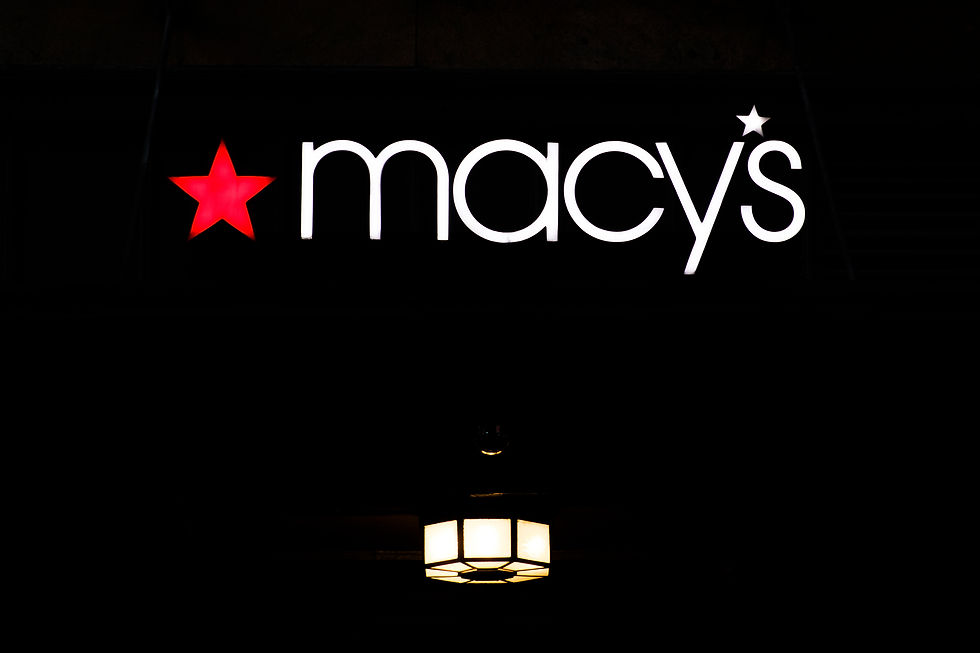Macy's Background
- Paulina Crum
- Apr 18, 2022
- 4 min read
Updated: May 3, 2022
As Macy's is 150 years in the retail business and a centerpiece of American culture, the company has a lot to lose.

History
In 1851, Rowland Macy opened up his first Macy’s Department Store in Haverhill, Massachusetts, which aimed to sell dry goods to mill workers in the surrounding community. It was one of three stores Macy began that failed soon after their founding.
Following this roadblock, Macy found success in 1858 with his first New York City dry goods store - R.H. Macy and Co., located on the corner of 14th Street and 6th Avenue. With unique products for the time, like various colored bath towels, Macy’s found its footing in New York City, America’s cosmopolitan center. This store was adorned with the now-iconic red-star logo, inspired by Macy’s time as a sailor, which would adorn all of the stores to come.
From the 1850s to early 20th century, various other department stores began to emerge across New York and the entire country. In 1895, Macy’s department stores were purchased by the Straus brothers.
Shortly after the purchase, Macy’s moved to Herald Square, and the location became the largest store in the world by 1924. It was that year the Macy’s Thanksgiving Day Parade first began, which garnered 10,000 spectators. Macy’s is very well known for their annual Thanksgiving Day Parade, a practice that began in 1924 and has continued without interruption (except for three years during World War II) since. The Macy’s Thanksgiving Day Parade of 2020 was scaled down to account for the coronavirus, but continued nonetheless.
In 1929, the holding company Federated Department Stores was formed, establishing corporate headquarters in Columbus, OH. The stores included the Abraham & Straus and F&R Lazarus (along with its Cincinnati-based subsidiary, Shillito's) and Filene's of Boston, and Bloomingdale’s in 1930.
The holding company became public in 1992 as the Federated Department Stores Inc. In the same year, Macy’s filed for bankruptcy. Two years later, Federated acquired R.H. Macy & Co., “creating the largest department store retailer in the nation,” according to the website. Later in 2007, the Corporation was renamed to Macy’s, Inc., and all of the Federation’s various department store lines take on the Macy’s name.
Today, Macy’s, Inc. consists of Macy’s, Bloomingdales and Blue Mercury, with online presences for each line and around 90,000 employees. However, this number is changing as Macy’s evolves their store formats and retail strategy.
Practices and Values
Win with Fashion and Style: We will win with fashion and style by delivering products that meet core and new customer needs across all occasions and transforming our assortment architecture, fashion curation, inventory productivity, and vendor relationships.
Deliver Clear Value: We will deliver clear value through simple, easy-to-understand pricing and promotions, deepening core and new customer engagement through hyper-personalized loyalty ecosystem, communication and personalized experiences.
Excel in Digital Shopping: We will excel in digital shopping by providing a modern, frictionless digital shopping journey, supported by a seamless user interface, immersive category-level experiences and a convenient deliver and returns experience that is fully connected to stores
Enhance Store Experience: We will reposition our store fleet and enhance omni experiences to create a tech-enabled, connected omni-ecosystem that supports a reimagined store experience through a streamlined stores portfolio and new off-mall formats.
Modernize Supply Chain: We will modernize our supply chain infrastructure by moving toward a faster and more efficient customer fulfillment infrastructure while profitable improving convenience and the delivery experience.
Enable Transformation: We will enable transformation through data analytics, technology and a performance-driven operating model, ensuring we have the right infrastructure and technology to execute and sustain our plans.
Financials
B2C business model
Income 23.5 B
Stock price has quadrupled since Oct. 2020
Gross profit is down $3M since 2018
COVID-19, like many other brick and mortar businesses, greatly affected Macy’s sales.
Past Promotions and Strategy
Coupons have been a serious promotional effort for Macy’s in the past. Within the past few years they have tried to translate this effort online with the “Macy’s Wallet.” (source)
They have also tried to embrace their perceived competitive advantage of an in-person shopping experience by enhancing that experience with new concepts and events.
“A new in-store strategy at Macy's is on prominent display at its Herald Square flagship in New York, where both The Market @ Macy's and b8ta concepts are placed just inside one of the entrances, at the intersection of 34th and 7th streets. Both installations came into being this year, the same year that Macy's acquired store concept Story, and invested in and partnered with b8ta.” (source)
Some of these events/pop-ups also attempt to open up Macy’s to new audiences, with The Market being targeted toward environmentally-conscious consumers. Update: Their only market store in Southlake, Texas has been shuttered but the plan to reopen with a different concept. (source)
TV Advertisements
Holiday Experiences
Thanksgiving Day Parade
Christmas traditions like wish list booklet and in-store sight-seeing decorations
Mail Fliers
Macy’s tiered membership and loyalty reward programs
Advertising & promotional efforts: As of 2021 Macy’s is leveraging first party shopper data to target consumers through their loyalty reward system to drive bigger basket sales and more engagement with the brand (MarketingDive, 2021).
Macy’s loyalty reward program offers members percent back in rewards. Based on annual purchases, shoppers can receive anywhere from 1%-5% back.



Comments